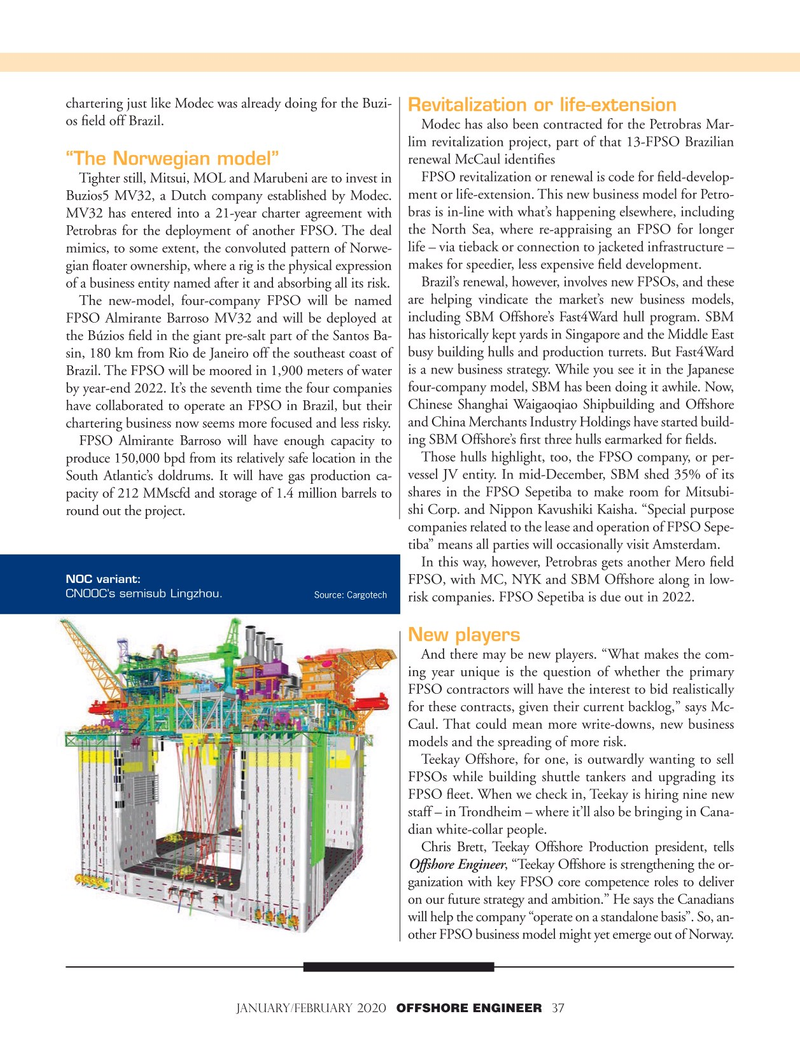
Page 37: of Offshore Engineer Magazine (Jan/Feb 2020)
Read this page in Pdf, Flash or Html5 edition of Jan/Feb 2020 Offshore Engineer Magazine
chartering just like Modec was already doing for the Buzi-
Revitalization or life-extension os ? eld off Brazil.
Modec has also been contracted for the Petrobras Mar- lim revitalization project, part of that 13-FPSO Brazilian renewal McCaul identi? es “The Norwegian model”
Tighter still, Mitsui, MOL and Marubeni are to invest in FPSO revitalization or renewal is code for ? eld-develop-
Buzios5 MV32, a Dutch company established by Modec. ment or life-extension. This new business model for Petro-
MV32 has entered into a 21-year charter agreement with bras is in-line with what’s happening elsewhere, including
Petrobras for the deployment of another FPSO. The deal the North Sea, where re-appraising an FPSO for longer mimics, to some extent, the convoluted pattern of Norwe- life – via tieback or connection to jacketed infrastructure – gian ? oater ownership, where a rig is the physical expression makes for speedier, less expensive ? eld development. of a business entity named after it and absorbing all its risk. Brazil’s renewal, however, involves new FPSOs, and these
The new-model, four-company FPSO will be named are helping vindicate the market’s new business models,
FPSO Almirante Barroso MV32 and will be deployed at including SBM Offshore’s Fast4Ward hull program. SBM the Búzios ? eld in the giant pre-salt part of the Santos Ba- has historically kept yards in Singapore and the Middle East sin, 180 km from Rio de Janeiro off the southeast coast of busy building hulls and production turrets. But Fast4Ward
Brazil. The FPSO will be moored in 1,900 meters of water is a new business strategy. While you see it in the Japanese by year-end 2022. It’s the seventh time the four companies four-company model, SBM has been doing it awhile. Now, have collaborated to operate an FPSO in Brazil, but their Chinese Shanghai Waigaoqiao Shipbuilding and Offshore chartering business now seems more focused and less risky. and China Merchants Industry Holdings have started build-
FPSO Almirante Barroso will have enough capacity to ing SBM Offshore’s ? rst three hulls earmarked for ? elds.
produce 150,000 bpd from its relatively safe location in the Those hulls highlight, too, the FPSO company, or per-
South Atlantic’s doldrums. It will have gas production ca- vessel JV entity. In mid-December, SBM shed 35% of its pacity of 212 MMscfd and storage of 1.4 million barrels to shares in the FPSO Sepetiba to make room for Mitsubi- round out the project. shi Corp. and Nippon Kavushiki Kaisha. “Special purpose companies related to the lease and operation of FPSO Sepe- tiba” means all parties will occasionally visit Amsterdam.
In this way, however, Petrobras gets another Mero ? eld
NOC variant:
FPSO, with MC, NYK and SBM Offshore along in low-
CNOOC’s semisub Lingzhou.
Source: Cargotech risk companies. FPSO Sepetiba is due out in 2022.
New players
And there may be new players. “What makes the com- ing year unique is the question of whether the primary
FPSO contractors will have the interest to bid realistically for these contracts, given their current backlog,” says Mc-
Caul. That could mean more write-downs, new business models and the spreading of more risk.
Teekay Offshore, for one, is outwardly wanting to sell
FPSOs while building shuttle tankers and upgrading its
FPSO ? eet. When we check in, Teekay is hiring nine new staff – in Trondheim – where it’ll also be bringing in Cana- dian white-collar people.
Chris Brett, Teekay Offshore Production president, tells
Offshore Engineer, “Teekay Offshore is strengthening the or- ganization with key FPSO core competence roles to deliver on our future strategy and ambition.” He says the Canadians will help the company “operate on a standalone basis”. So, an- other FPSO business model might yet emerge out of Norway.
JANUARY/FEBRUARY 2020 OFFSHORE ENGINEER 37

 36
36

 38
38